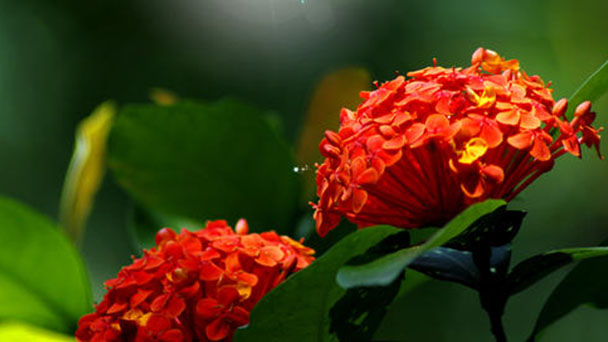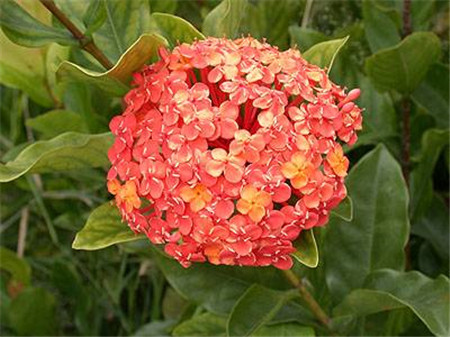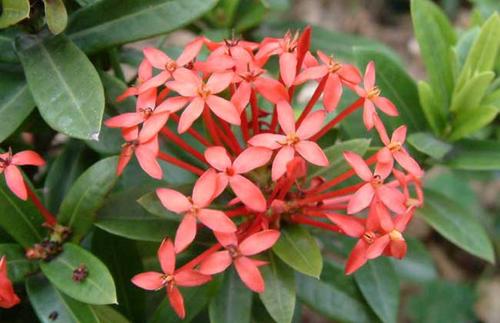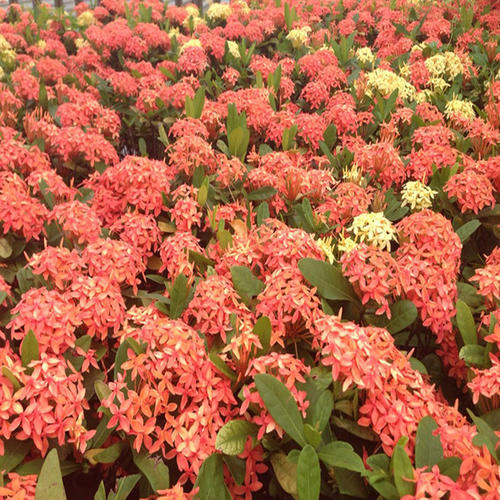Chinese ixora profile
Written by Maggie
Oct 16 2021

Chinese Ixora (Ixora chinensis) is an evergreen shrub known as dwarf elixir. Chinese Ixora is originally produced in the south of China and Malaysia, most of the common orange flowers. But there are also other varieties of white or yellow flowers, peach, pink, etc., which are mostly native to India and other areas of the foreign Chinese ixora is one of the "Okinawa three famous flowers'', is the city flower of Okinawa Uruma City.
Chinese Ixora picture

Chinese ixora characteristics
Flowers
The flowers of chinese ixora are terminal cymbals. Each cluster has about 20-30 small flowers growing from its corona tube and then dividing into 4-5 elliptic petals. The length of the corona tube is about 2.5 cm, and the corolla is mostly red brick. 20-30 clusters of florets present a large spherical whole, flowers, shaped like hydrangea, so do not call it "red hydrangea". It is also famous for the mountain Danshan, which is native to South China. Even in Chinese ixora, although 20-30 small flowers gather and grow together, most of them are semicircular in appearance, and their petals are pointed and long. In Okinawa, Japan, because the flowering period of this flower is three times a year, and the pedicels are three segments overlapping, so it also has the nickname of "three segments flower".
Fruit
Chinese Ixora has a long flowering period. Generally speaking, flowering can be seen from late April to late January of the next year, and the flowering period is about mid-May to late November. There are also spherical berries growing, but in general, most of them are not fruiting, so we can rarely see the results of Chinese Ixora.
Chinese ixora habits
Chinese Ixora grows in thickets and under sparse forests in mountainous areas at an altitude of 200-800 meters, sometimes on hillsides near villages and along open roads. Chinese Ixora likes warm, humid and sunny environments, not cold resistant, resistant to half shade, resistant to moisture and strong light. Chinese Ixora is a drought tolerant plant, sun tolerant, more drought tolerant, warm and humid climate. It is suitable to grow in fertile loose and slightly acidic soil.
The propagation methods of Chinese Ixora
Propagation is often done by cutting. Take annual branches in the rainy season, cut them into a section of 10-15cm long, remove the base leaves, cut them at room temperature of 24 ~ 30℃, and insert them in the sand bed (basin) or directly in the ground bed of sandy soil. For example, before cutting, use 0.5% indolebutyric acid solution to soak the base of cuttings for 3 ~ 5 seconds, which can shorten the rooting period, and the root system is particularly developed. After planting, water the sand soil every day to keep it moist. It can take root in about 30 days. After taking root, it can be transplanted or put into the pot 10 days later. Sowing propagation: Seed in winter, the next spring sowing, germination suitable temperature 22 ~ 24℃, indoor seedling plate sowing, about 20 ~ 25 days germination. When 3 ~ 4 pairs of true leaves grow, seedlings can be transplanted in an 8 cm basin. But the mature stage is longer. In the case of many branches and dense, we can also use layering propagation, 20 cm from the top, line ring peat, with peat and film binding up, about 2 months can heal the root.

Growing management of Chinese Ixora
Chinese Ixora likes sunshine, warmth, and is not cold resistant. It should be placed in sunny courtyards, roof gardens, and balconies facing south and west. When the minimum temperature drops to 5℃ in winter, it should be moved into the room and placed in the sunny place of the windowsill for maintenance. The next spring, when the temperature stabilizes above 10℃, it can be safely overwintered. Chinese Ixora can also be potted besides ground planting. We should choose the clay basin with better permeability, such as the purple sand basin and plastic basin with poor permeability and better appearance. It can be broken tile or broken hard plastic foam block in the basin bottom cushion, enhancing air permeability and drainage. Basin soil should be rich in humus, loose, fertile acid soil, pH value of 5.0 ~ 6.5 is appropriate. Avoid using saline-alkali soil and heavy clay. The culture soil can be prepared according to 4 parts of leaf rot soil, 4 parts of sandy loam soil, 2 parts of river sand, and properly mixed with some already ripe bean cake powder or sesame oil residue, and we can also put a little hoof powder on the bottom of the basin as bottom fertilizer. Potted plants in early April out of the house, placed in half shade for maintenance. Chinese Ixora like fertilizer, half a month or so during the growth period of a small amount of N, P and K compound fertilizer, not only nitrogen fertilizer, otherwise the leaves and branches are long and less flowers. From the middle of April to the beginning of May, the decomposed bean cake water was applied twice; from the middle of May to the beginning of May, the decomposed liquid fertilizer mixed with nitrogen and phosphorus was applied 2-3 times; Flower-stage also need topdressing 2- 3 times of decomposed phosphorus liquid fertilizer. Basin soil to see dry see wet, see dry that is poured, pouring through that is not waterlogging. In spring 4 days a water, the summer generally 1 ~ 2 days a water, and around the potted flowers every morning and evening sprinkling once, in order to improve the air humidity. In summer soft water irrigation is appropriate, hard water on Chinese Ixora growth adverse, light leaves yellow, heavy death. To overcome the alkalinity of soil and water, water alum fertilizer once a week during the growing season to keep the plants green. In autumn appropriately control water, and can make branch organization enrichment. In winter we should strictly control the amount of watering. Water north of the Yangtze River, it is appropriate to add ferrous sulfate in water (500∶1), in order to prevent long-term use of alkaline water irrigation, salinization of soil, leaves yellow, plants die. When the height of the seedling is 15 ~ 20cm, the top should be cut once to promote its multiple lateral branches and plump into shape as soon as possible. When pruning Chinese Ixora, attention should be paid to cutting the heart. When the seedlings are 15 to 20 cm high, pick the heart once, promote its multiple branches, so that the plant shape plumps. They should also be pruned several times after flowering. Every spring when changing the pot for soil, the old plants over the winter to leave about 20 centimeters for a re-cut. Old plants should be potted and replaced once a year. In winter, South China can overwinter on open ground, other places need to move into the room, the room temperature is not lower than 2 °C. Scale insects are easy to occur in the growing period, which should be controlled in time.
Chinese Ixora main use
Chinese Ixora is suitable for garden beautification and potted.

Latest Updated
- Benefits of Bugleweed - 7 Science-backed Health Benefits
- Bugleweed Dangers & Side Effects - Is It Poisonous?
- How to Plant Evergreen Trees - What You Should Know
- When to Plant Evergreens - Grow Guide for Evergreen Trees
- 12 Wonderful Evergreen Shrubs for Your Garden
- 12 Popular Evergreen Plants with Pictures for Beginners
- When And How To Prune A Lilac Bush Like a Pro
- How to Grow & Care for Lilac Vine (Hardenbergia Violacea)
- Japanese Lilac Tree (Syringa Reticulata) Care & Propagation Guide
- Shumard Oak Pros and Cons - What to Know
Popular Articles
- Winter maintenance of Antirrhinum Majus
- How to Grow Terminalia Mantaly Tree
- How to Grow and Care for Crossostephium Chinense
- How to grow Antirrhinum Majus in spring
- Peristeria Elata (Dove Orchid) Profile: Info & Care Guide
- Underwatered Snake Plant (Sansevieria Trifasciata) - Signs And How To Fix
- How to Care for Brazilian Jasmine Plant (Mandevilla Sanderi)
- How to Grow & Care for Graptopetalum Purple Delight in Summer
- Rosa Chinensis (China Rose): Plant Growing & Care Tips
- How to Care for Baby Sun Rose (Aptenia Cordifolia)